There are nine short-legged cat breeds. Although they all have unique appearances, they all express the chondrodysplasia gene they inherited by crossing their parents with a Munchkin cat.
Chondrodysplasia (sometimes called achondroplasia) causes abnormal growth plates in long bones leading to stunted growth of long bones (primarily the bones of the front and back legs). This is the same genetic mutation that short-legged dog breeds such as the Dachshund, Basset, and Pekingese carry.
Pet Vet Tip: To read more on how chondrodysplasia causes cats to have short legs and how short legs affects their backs, have a looked at the linked articles.
Nine Short-Legged Cat Breeds
1. Bambino
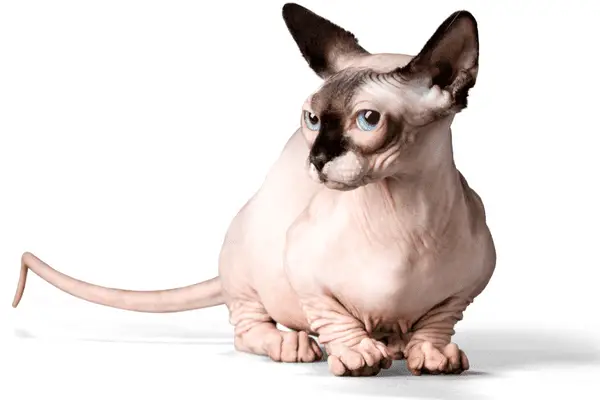
The Bambino is a crossbreed between the Sphynx and Munchkin cat.
Bambinos are friendly, lively, intelligent, and affectionate. However, they are also commonly known to be very talkative and love to vocalize just as much as Sphynx cats do!
As with the Sphynx cat, the Bambino comes in brown, white, black, and cream. It is also important to note that, like Sphynx cats, Bambinos’ skin requires special care, including frequent baths and sun protection.
2. Dwelf

The Dwelf is the result of crossing a Sphynx, an American Curl, and a Munchkin cat.
This cat breed is still relatively new and, therefore, a rare and often expensive cat breed. Dwelfs are similar in appearance to Bambinos, with the added characteristic of their slightly curled ears.
Dwelf cats are good family pets because they are playful and affectionate and get along well with other cats, dogs, and children.
The Dwelf cat has a limited color pallet of black and cream.
3. Genetta

The Genetta is a crossbreed between the Bengal, Savannah, and Munchkin cats.
The Bengal cat is a domestic hybrid between the wild Asian Leopard cat and the Egyptian Mau, while the Savannah is a cross between a serval and a domestic cat.
Genetta cats have a beautiful marbled or striped coat, which comes in a variety of brown, orange, red, and black.
4. Kinkalow

The Kinkalow is the result of crossing an American Curl and a Munchkin cat.
These cats are the furry version of the Dwelf and are known for their “dog-like” attributes, such as following their owners everywhere they go and being loyal and affectionate. So naturally, these cats need a lot of attention and devotion from their owners.
Kinkalows can be chocolate, white, tabby, tortoiseshell, gray, cream, or black.
5. Lambkin
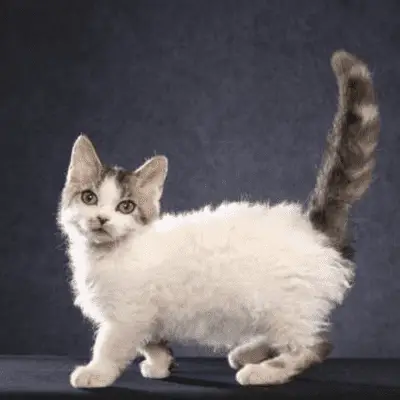
The Lambkin is a crossbreed between the Selkirk Rex and the Munchkin cat.
Lambkins are known for their curly fur coats and form strong and close bonds with their owners. They are calm, loving, highly tolerant, and affectionate cats. However, lambkins do not tolerate being alone for extended periods.
Lambkins come in any color and pattern, but white is the most common and favored color variation.
6. Minskin
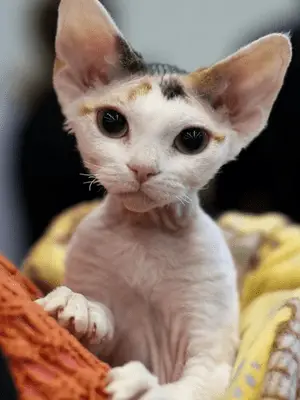
The Minskin is the result of crossing the Sphynx, the Munchkin, the Devon Rex, and Burmese cat. Although the latter two were added later in the development of this breed, thus creating the Minskin as we know it today.
Like the Bambino, Minskins are predominately hairless but can have tufts of short fur on their extremities. They are tremendously friendly and playful, and with that, can also be mischievous.
These wrinkled babies are commonly color-pointed in white, cream, and brown.
7. Napoleon

The Napoleon cat is a crossbreed between a Persian and a Munchkin cat.
Napoleons are very docile and friendly. They are not as lively as the other cats on the list, but as with all other cats, they might be a little naughty occasionally.
Napoleons get along well with other animals and people but don’t like being left alone for very long, so you can expect to have your Napoleon with you at all times.
These adorable, doll-faced cats come in various colors but are mostly white, cream or chocolate only.
8. Scottish Fold Munchkin
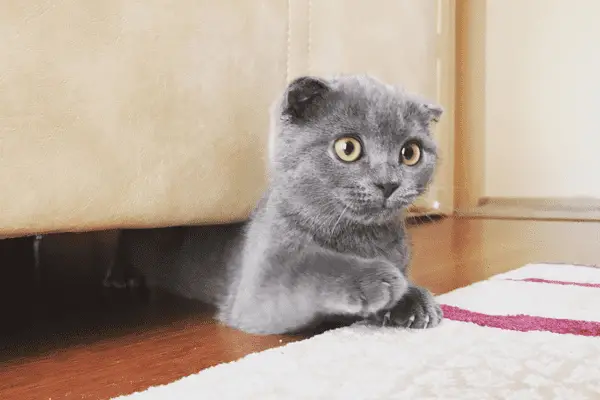
As the name gives away, these cats are crossbreeds between the Scottish Fold and the Munchkin cat.
These folded-eared cats are playful, cheerful, and sweet-natured. They make excellent family pets as they are rarely aggressive.
9. Skookum
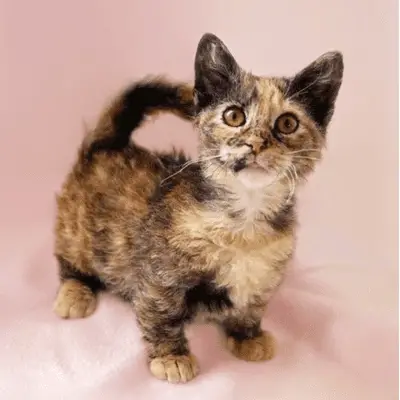
The Skookum cat is the result of crossing a LaPrem and Munchkin cat. As a result, the Skookum possesses the characteristic short legs of the Munchkin parent and the curly coat of the LaPerm parent.
For the most part, the Skookum is laidback, but they are playful sometimes, making them fantastic family pets. They are loyal, affectionate, intelligent cats and love being around humans.
Skookums come in an array of solids colors, two-tone color points, and various patterns.
Lifespan
These Munchkin crossbreeds, weighing between 4-9 pounds, have a lifespan of 10-15 years. Some breeds may have a slightly shorter life expectancy of 8-12 years, such as the Dwelf, and other breeds, such as the Genetta and Lambkin, have a somewhat higher life expectancy of up to 16 and 20 years, respectively.
Health Issues
Aside from the genetic mutation causing the short limbs in the Munchkin cat and crossbreeds, these cats are generally very healthy, provided they were responsibly bred.
Owing to their body conformation, all Munchkin crossbreeds are prone to genetic issues related to their chondrodysplasia, such as osteoarthritis, lordosis, and pectus excavatum.
Additionally, breed-specific illnesses may also be present in these Munchkin crosses.
- Bambinos are prone to Hypertrophic Cardiomyopathy from the Sphynx parent. The other crosses, such as the Dwelf and Minskin, may also be prone to HCM but to a lesser extent. These crosses can also be more prone to Malassezia yeast infections on the skin as well as skin allergies.
- Napoleons have more health issues than other Munchkin crosses. Diseases such as Polycystic Kidney Disease, Cataracts, Lysosomal Accumulation, Neuropathy, Peritoneopericardial Defect, Photophobia, and respiratory trouble due to being brachycephalic (flat-faced). These conditions are from the Persian parents’ gene in the Napoleon.
- The Scottish Fold Munchkin is prone to painful Osteoarthritis, Polycystic Kidney Disease, and Cardiomyopathy.
Remember to visit your veterinarian for vaccinations and annual check-ups to ensure the health and well-being of your cat.
Caring For Short-Legged Cat Breeds
Cats are clean animals and relatively low maintenance due to their self-grooming nature; however, some of these Munchkin crossbreeds require a little more attention and care.
Cats with little or no fur, such as the Bambino, Dwelf, and Minskin, require frequent baths to keep their skin healthy and soft by eliminating excess sebum, which can lead to health complications such as yeast infections or by exacerbating skin allergies.
Hairless cats need to be protected from excessive exposure to the sun as they can suffer from painful sunburn and eventually skin cancer if exposed to harmful UV rays daily for extended periods. Additionally, these cats will need to be kept warm in the winter by keeping them indoors and providing a jersey.
On the other end of the spectrum, cats such as; the Kinkalow, Lambkin, Napoleon, and Skookum with long fur will need to be brushed two to three times a week. Other furry breeds, such as the Genetta and Scottish Fold Munchkin, may only need to be brushed every other day.
Conclusion
Due to these cats’ body conformation, it might be necessary to make some minor adaptations or purchase pet stairs to help your cat get onto or come down from different places around the home.
These short-legged cat breeds are super adorable and come with many different personalities to complement your personality and lifestyle and make great family pets.
When considering getting a short-legged cat for your family, make sure to purchase from a responsible breeder.
Since most of these short-legged cats are still relatively new cat breeds, their genetic pools are still small, as the desired physical traits are often acquired by crossing closely related relatives (line breeding). This also means that many of these cats commonly carry recessive genes that make them prone to genetic health conditions.

